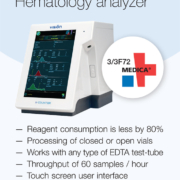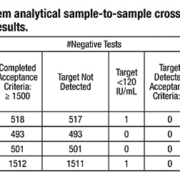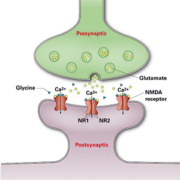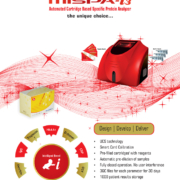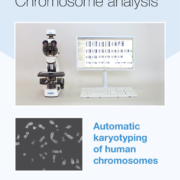Although known to the ancient Greeks, celiac disease was definitively demonstrated only in the late 1950s after development of the endoscope. In 1969, the new European Society for Pediatric Gastroenterology, Hepatology and Nutrition (ESPGHAN) codified the first diagnostic criteria for the disease.
Fast-growing challenge
The prevalence of celiac disease has exploded in recent years, above all in North America, Europe and Australia. The Association of European Coeliac Societies (AOECS) notes that those with the condition, but unaware of it, are compelled to live a life “filled with chronic pain and discomfort.”
If unchecked, inflammation caused by celiac disease seriously damages the lining of the small intestine, which produces enzymes for the digestion and absorption of food and essential nutrients. The malabsorption leads to diarrhea, weight loss and fatigue. Celiac disease eventually impacts on the bones, liver, brain and nervous system, in some cases seriously. AOECS includes “infertility, osteoporosis and small bowel cancer” in its list of long-term risk factors.
The role of prolamins
The principal protein responsible for celiac disease consists of prolamins, which are resistant to proteases and peptidases of the gut. They stimulate intestinal membrane cells in susceptible people to become permeable (or ‘leak’), by allowing larger peptides to bypass the sealant between cells, and thereby enter circulation.
The best understood prolamin is gliadin (in wheat). Other prolamins believed to play a role include hordein in barley, scelain in rye and zein in corn. The role of avenin in oats as a causative factor for celiac disease remains unclear. In Europe, however, the EU Commission requires that gluten-free oats are specially produced or processed to avoid contamination by wheat, rye and barley.
Prevalence growth ‘mystifying’, increase uneven
Estimates on the prevalence of celiac disease have leaped dramatically in recent years. It was previously believed that it affected about 1 in 1,500 people. However, new studies suggest a 15-fold higher rate, about 1 in 100 (1%) in both Europe, and the US. As the ‘New York Times’ observed last year, the spike in US prevalence of celiac disease is “mystifying.”
In Europe, prevalence varies widely. In the 30–64 year age group, the rate in Finland is eight times higher than in Germany (2.4% versus 0.3%). In addition, Finland has also shown a doubling in prevalence over 20 years – a fact which “cannot be explained by better detection rates.”
There is a higher prevalence of celiac disease in people with other conditions, such as Type 1 diabetes, Down Syndrome as well as both hypo- and hyper-thyroidism.
Genetics and environment
The challenges of celiac disease are manifold.
Its etiology is unclear. The disease is caused by “a combination of immunological responses to an environmental factor (gluten) and genetic factors.” The latter consist of the cellular receptors for two versions of HLA (human leukocyte antigen), DQ2 or DQ8. The absence of either results in “a negative predictive value … close to 100%.” This explains why people of Chinese, Japanese and African descent – who lack the HLA allele – are rarely diagnosed with celiac disease, unlike Caucasians.
Nevertheless, in a confirmation of the role of environmental triggers, the presence of HLA-DQ2 or -DQ8 is “necessary but not sufficient to predispose people to celiac disease.” In addition, the genes may be transmitted to some family members, but not others. First- and second-degree relatives of people with celiac disease show prevalence rates of about four-and-a-half and two-and-a-half times that of the general population.
The no-man’s land of gluten sensitivity
The symptoms of celiac disease are also varied, since it affects people differently. One of the best illustrations of the scale of the diagnostic challenge is the University of Chicago’s Celiac Disease Center, which lists as many as 300 symptoms that may accompany the disease.
Celiac disease is also routinely confused with irritable bowel syndrome. Indeed, a paper in 2009 published in the ‘American Journal of Gastroenterology’ remarks about the ‘no-man’s land of gluten sensitivity’ lying between celiac disease and irritable bowel syndrome.
As the US-based Celiac Disease Foundation observes, such factors make the disease difficult to diagnose. In addition, some patients have no symptoms at all.
Europe’s AOECS notes that only about 12%-15% of celiac disease patients obtain a diagnosis. In many cases, moreover, the time between experiencing first symptoms and diagnosis is over 10 years.
Confounding matters further is a lack of physician awareness about the onset of symptoms. Surveys in the US have shown that only 35% of primary care physicians had ever diagnosed celiac disease.
Peaks in diagnosis occur in childhood and between the fifth and seventh decades of life. The female-to-male ratio in celiac disease is about 2:1.
Strict diet only answer
There is no cure for celiac disease.
A gluten-free diet is used to manage symptoms and promote intestinal healing. The diet is strict and demanding. Patients can relapse if gluten is reintroduced, for some even in trace quantities, and people preparing gluten-free meals are urged to do so separately from other foods.
The only recommended preventative action against celiac disease is to avoid wheat-containing foods in an infant’s diet for six months after birth. Gluten increases the risk of developing celiac disease by five times, “within the first 3 months or after 7 months” of age.
In Europe, a 2006 EU Commission Directive bans the use of gluten containing foods in infant formula. The US, however, has no similar rule and the Celiac Disease Center at the University of Chicago simply notes that “most baby formulas are gluten-free.”
Guidelines for celiac disease
The original 1969 diagnostic criteria for CD by the European Society for Pediatric Gastroenterology, Hepatology and Nutrition (ESPGHAN) were revised in 1990, and most recently in 2011. Along with clinical guidelines from the North American Society for Pediatric Gastroenterology, Hepatology and Nutrition, these reflect the current consensus for celiac disease in pediatric practice.
In adults, testing for celiac disease is recommended only for symptomatic individuals and those in high risk groups. Screening is explicitly ruled out in asymptomatic patients, for example by the American Association of Family Physicians (AAFP).
Health authorities in many countries follow guidelines from the World Gastroenterology Organization (WGO).
For the WGO, celiac disease is based on patients having “characteristic histopathologic changes in an intestinal biopsy,” along with clinical improvement after a gluten-free diet.
The WGO’s latest guidelines specify serological tests for identifying patients in whom biopsy might be warranted, and investigating high-risk patients (including first- and second-degree relatives). The tests include immunoglobulin A (IgA) endomysial antibody (EMA), IgA anti-tissue transglutaminase antibody (tTG) and IgA and immunoglobulin G (IgG) deamidated gliadin peptide (DGP) antibodies. Small-bowel biopsy, however, is considered a ‘gold standard’ by the WGO.
The UK was one of the first countries to consider diagnosis and management of celiac disease in general practice. In 2008, the National Institute for Health and Clinical Evidence (NICE) published guidelines for testing both adults and children presenting a variety of symptoms. These are mainly gastrointestinal, which the WGO classifies as ‘classical’, but also include anemia and weight loss, which are grouped by the WGO as ‘atypical’. The list also extends to about 25 specific conditions, which extend well beyond Type 1 diabetes, dermatitis herpetiformis, thyroid disorders and Down Syndrome – long associated with an increased prevalence of celiac disease – to areas such as chronic fatigue syndrome, epilepsy, mouth ulcers, low-trauma fractures and sub-fertility.
In the US, the Agency for Healthcare Research and Quality (AHRQ) recommends WGO guidelines. However, new initiatives are expected after the recent formation of the North American Society for the Study of Celiac Disease (NASSCD). The Society was set up at the International Celiac Disease Symposium in Oslo, Norway last June.
Screening: challenges, ethical issues
At the moment, the broader political response to celiac disease has been largely focused on regulating gluten-free foods.
On the horizon, however, are efforts by celiac disease patient groups to increase the scope of screening. The outlook for this, however, remains unclear – in spite of the experience of an exception such as Italy, where everyone is screened by the age of six.
In June 2005, ‘Best Practice & Research – Clinical Gastroenterology’ published a paper headlined ‘Coeliac disease: is it time for mass screening?’. The authors argued that since antibody screening “may have to be repeated during each individual’s lifetime,” HLA typing of people with DQ2 or DQ8 would allow for “one-off exclusion of a large percentage of the population”. However, they agreed that gene-based screening would be confounded by ethical issues. They also noted that the costs of screening versus prevented morbidity were unknown.
Raising awareness in healthcare professionals
In 2010, a Markov model study provided answers to both the above questions. The study, by an Israeli medical team found that even IgA anti-tTG antibody mass screening – accompanied by confirmatory intestinal biopsy – was “associated with improved QALYs” (quality adjusted life years) as well as cost effectiveness. Nevertheless, the authors of the study also noted that shortening the delay to diagnosis “by heightened awareness of healthcare professionals” could be a valid alternative to screening.
In the years to come, it is clear that physicians at least are going to become far more aware of celiac disease.





